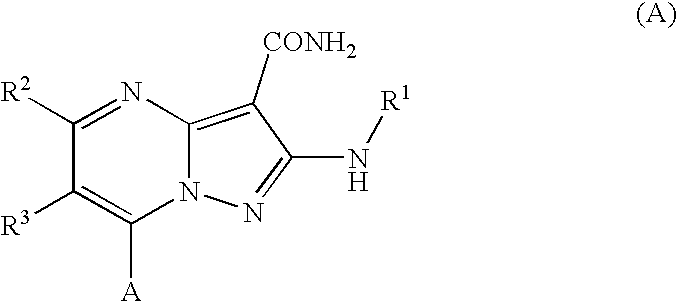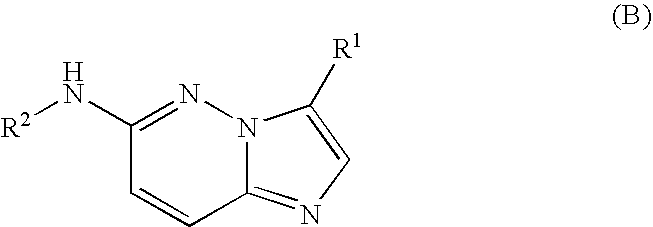Fused heterocycles as lck inhibitors
a heterocycle and inhibitor technology, applied in the field of imidazopyridazine or pyrazolopyrimidine derivatives, can solve the problem that the effect of lck inhibitors is limited to lymphocytic organs
- Summary
- Abstract
- Description
- Claims
- Application Information
AI Technical Summary
Benefits of technology
Problems solved by technology
Method used
Image
Examples
preparation 1
[0081]The solution of 5-chloropyrazolo[1,5-a]pyrimidine (200 mg) and trans-4-methoxycyclohexanamine (168 mg) in isopropylalcohol (2 ml) was refluxed for 3 hours. After cooling to ambient temperature, the reaction mixture was poured into water, then extracted with ethyl acetate. The organic layer was washed with brine, dried over magnesium sulfate, and evaporated in vacuo. The residue was purified by column chromatography on silica gel eluting with chloroform / methanol (100:0 to 100:10) to give N-(trans-4-methoxycyclohexyl)pyrazolo[1,5-a]pyrimidin-5-amine (70 mg).
[0082]1H-NMR (DMSO-d6) δ: 1.13-1.34 (4H, m), 1.91-2.08 (4H, m), 3.09-3.20 (1H, m), 3.33 (3H, s), 3.70-3.86 (1H, m), 5.95 (1H, d, J=2.0 Hz), 6.19 (1H, d, J=7.6 Hz), 7.26 (1H, d, J=7.4 Hz), 7.74 (1H, d, J=2.0 Hz), 8.41 (1H, d, J=7.6 Hz).
[0083]MS: 247 (M+H)+.
preparation 2
[0084]To a stirred mixture of 6-chloro-3-iodoimidazo[1,2-b]pyridazine (100 mg) and 4-(4,4,5,5-tetramethyl-1,3,2-dioxaborolan-2-yl)pyridine (220 mg) in 1,2-dimethoxyethane (3.3 ml) was added aqueous 2M NaOH aqueous solution (1.08 mL) at ambient temperature. Tetrakis(triphenylphosphine) palladium(0) (24.8 mg) was then added to the mixture at ambient temperature. After addition, the resulting mixture was stirred at 85° C. for 1 hour. The reaction mixture was cooled to ambient temperature and diluted with ethyl acetate / water (20 mL / 20 mL). The resulting mixture was acidified with 1M HCl aqueous solution to pH 2 and extracted with ethyl acetate. The aqueous phase was then neutralized by the addition of 2M NaOH aqueous solution to pH 8. The resulting solution was extracted with ethyl acetate three times, the organic layers were combined, dried over magnesium sulfate, and concentrated in vacuo. The residue was purified by silica gel column chromatography eluting with chloroform / methanol (2...
preparation 3
[0088]To a solution of 2-(4-methyl-3-nitrophenoxy)tetrahydro-2H-pyran (4750 mg) in methanol (100 mL) was added 10% palladium on carbon (600 mg). The resulting mixture was stirred under atmospheric hydrogen at ambient temperature for 3 hours. The mixture was filtered through Celite and washed with methanol. The filtrate was concentrated in vacuo to give 2-methyl-5-(tetrahydro-2H-pyran-2-yloxy)aniline (4140 mg).
[0089]1H-NMR (DMSO-d6) δ: 1.45-1.92 (6H, m), 1.96 (3H, s), 3.45-3.58 (1H, m), 3.68-3.80 (1H, m), 4.79 (2H, bs), 5.25 (1H, t, J=3.0 Hz), 6.12 (1H, dd, J=2.5, 8.5 Hz), 6.29 (1H, d, J=2.5 Hz), 6.76 (1H, d, J=8.5 Hz).
[0090]MS: 230 (M+Na)+.
[0091]The following compound was obtained in a similar manner to that of Preparation 3.
PUM
| Property | Measurement | Unit |
|---|---|---|
| temperature | aaaaa | aaaaa |
| pH | aaaaa | aaaaa |
| pH | aaaaa | aaaaa |
Abstract
Description
Claims
Application Information
 Login to View More
Login to View More - R&D
- Intellectual Property
- Life Sciences
- Materials
- Tech Scout
- Unparalleled Data Quality
- Higher Quality Content
- 60% Fewer Hallucinations
Browse by: Latest US Patents, China's latest patents, Technical Efficacy Thesaurus, Application Domain, Technology Topic, Popular Technical Reports.
© 2025 PatSnap. All rights reserved.Legal|Privacy policy|Modern Slavery Act Transparency Statement|Sitemap|About US| Contact US: help@patsnap.com



